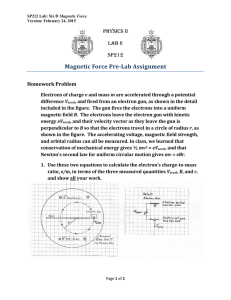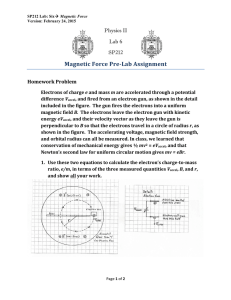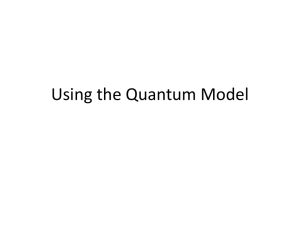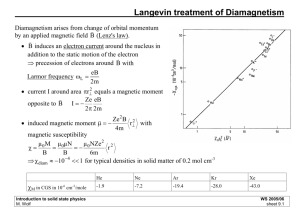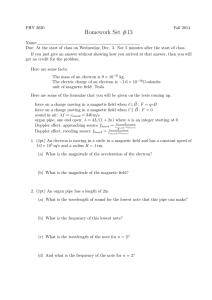Generation of Suprathermal Electrons during Magnetic Reconnection
advertisement
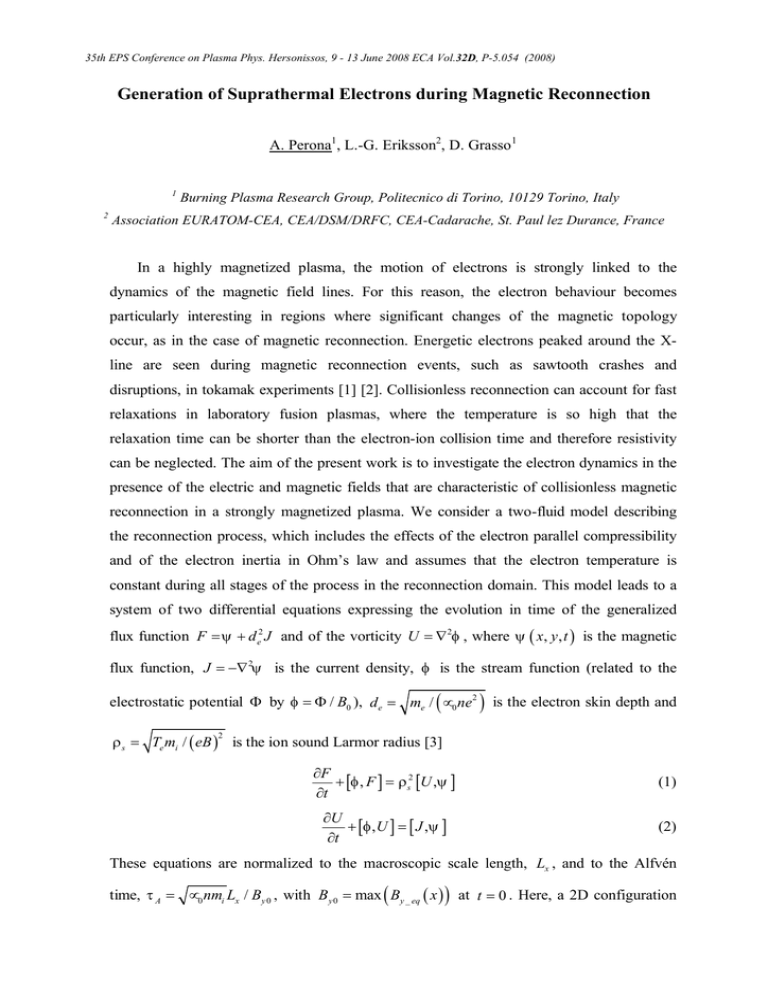
35th EPS Conference on Plasma Phys. Hersonissos, 9 - 13 June 2008 ECA Vol.32D, P-5.054 (2008) Generation of Suprathermal Electrons during Magnetic Reconnection A. Perona1, L.-G. Eriksson2, D. Grasso1 1 2 Burning Plasma Research Group, Politecnico di Torino, 10129 Torino, Italy Association EURATOM-CEA, CEA/DSM/DRFC, CEA-Cadarache, St. Paul lez Durance, France In a highly magnetized plasma, the motion of electrons is strongly linked to the dynamics of the magnetic field lines. For this reason, the electron behaviour becomes particularly interesting in regions where significant changes of the magnetic topology occur, as in the case of magnetic reconnection. Energetic electrons peaked around the Xline are seen during magnetic reconnection events, such as sawtooth crashes and disruptions, in tokamak experiments [1] [2]. Collisionless reconnection can account for fast relaxations in laboratory fusion plasmas, where the temperature is so high that the relaxation time can be shorter than the electron-ion collision time and therefore resistivity can be neglected. The aim of the present work is to investigate the electron dynamics in the presence of the electric and magnetic fields that are characteristic of collisionless magnetic reconnection in a strongly magnetized plasma. We consider a two-fluid model describing the reconnection process, which includes the effects of the electron parallel compressibility and of the electron inertia in Ohm’s law and assumes that the electron temperature is constant during all stages of the process in the reconnection domain. This model leads to a system of two differential equations expressing the evolution in time of the generalized flux function F = ψ + d e2 J and of the vorticity U = ∇ 2φ , where ψ ( x, y , t ) is the magnetic flux function, J = −∇ 2ψ is the current density, φ is the stream function (related to the electrostatic potential Φ by φ = Φ / B0 ), de = me / ( µ0 ne 2 ) is the electron skin depth and ρ s = Te mi / ( eB ) is the ion sound Larmor radius [3] 2 ∂F + [φ , F ] = ρ s2 [U ,ψ ] ∂t (1) ∂U + [φ , U ] = [ J ,ψ ] ∂t (2) These equations are normalized to the macroscopic scale length, Lx , and to the Alfvén time, τ A = µ0 nmi Lx / By 0 , with By 0 = max ( By _ eq ( x ) ) at t = 0 . Here, a 2D configuration 35th EPS 2008; A.Perona et al. : Generation of suprathermal electrons during magnetic reconnection 2 of 4 with a strong (constant) magnetic field in the z-direction has been considered and the coordinate along z was neglected. In order to study the changes occurring in the parameters of the electron population, such as the density and the temperature, a kinetic code has been written. A δ f method is adopted to simulate the perturbed electron distribution function, which allows us to resolve small fluctuations in the distribution function away from its equilibrium Maxwellian state. A 2D fluid code [4], based on the reconnection model described above, solves eqs. (1) and (2) as an initial value problem, with no equilibrium electric field and an equilibrium magnetic flux function ψ eq = 1.3 / cosh 2 ( x ) (the coefficient 1.3 has been fixed in such a way that the corresponding magnetic field is always normalized to unity). The boundary conditions are periodic along the y direction, while in the x direction the box size is large enough to allow vanishing boundary conditions for the perturbed fields ψ and φ . At each time step, the electron kinetic code reads the perturbed fields provided by the fluid code, and calculates the parallel electric field E|| = −∇||Φ − ∂ψ / ∂t , simultaneously advancing the spatial location of each marker, its parallel position and the change in its weight. We investigated a collisionless reconnection process referring to an unstable equilibrium flux in the limit of a large tearing mode stability parameter ∆' (in our case, ∆ ' = 59.9 for the m = 1 mode). The initial temperature and density of electrons are derived from the input parameters of the reconnection code, de and ρ s . In order to verify whether the electric field created during the magnetic reconnection process leads to the generation of suprathermal electrons, for which 1 1 m v 2 > kTe , a relativistic Hamiltonian formulation of the electron guiding-centre 2 2 dynamics was chosen [5]. Our simulations have been carried out considering a guide field (that can be viewed as the equivalent of the toroidal field in a tokamak) B0 = 1 T , a ‘poloidal’ field B y 0 = 0.1 B0 , an electron density n = 1019 m −3 and an initial electron temperature of 1 keV . 400,000 electrons are initially loaded in the 4-D phase-space ( x, y , p|| , p⊥ ) as a shifted Maxwellian centered about the equilibrium parallel momentum p||0 derived from the equilibrium current density p||0 = J eq / ( me ne ) . The investigation of single electron orbits shows that, while the particles follow the field lines as expected during the linear phase, the structure of the parallel electric field becomes much more complex in the super-exponential phase (when it reaches values of the order of 104 V/ m ), thus allowing only a small fraction of electrons not to be ‘trapped’ in the wells of the 35th EPS 2008; A.Perona et al. : Generation of suprathermal electrons during magnetic reconnection 3 of 4 electric potential. This is confirmed by the evolution of the equilibrium Maxwellian distribution function of electrons, whose tail is slightly deformed during the superexponential phase of the process although, also at this time, no electrons, freely streaming along the magnetic field lines, reach relativistic velocities. The ‘parallel’ electron temperature Te|| ≡ p|| / n , calculated as the ratio between the second and the zeroth order moments of the distribution function, remains uniformly distributed in the spatial domain during the linear phase and reflects the behaviour of the pressure during the nonlinear stage of the reconnection process, where two hotter regions may be observed at the location of the regions with larger pressure and density. The value of the temperature in these regions rises to Te ≈ 3.5 keV , more than three times the value of the temperature at t = 0 , while Te is about one half of the initial temperature in the coldest regions (Fig.1). ln ψ ψ (a) (b) ne Te (c) (d) Figure 1. Initial temperature: 1 keV. The reconnected flux as a function of time (in logarithmic scale) (a) and contour plot of the arising magnetic island (b) taken from the fluid code. Contour plots of the electron density (in m −3 ) (c) and of the electron temperature (in eV) (d) calculated in the kinetic code during the nonlinear phase. This result is confirmed when considering an initial electron temperature of 0.2 keV . In this case, however, the evolution of the reconnection process is much slower and the value of the parallel electric field is about 5 times smaller than in the 1 keV case. Thus, the 35th EPS 2008; A.Perona et al. : Generation of suprathermal electrons during magnetic reconnection 4 of 4 E× B drift does not move away too rapidly electrons from the region in the vicinity of the X-line, where the electric field is initially stronger. A large fraction of the bulk electrons can therefore enhance its velocity, thus becoming suprathermal. Therefore, the deformation of the distribution function in the nonlinear phase is much more significant than in the 1 keV case (Fig.2). Electrons keep streaming along the magnetic field lines almost until the end of the nonlinear stage, when they become trapped and two hotter regions (with a maximum peak of about 1 keV ) form along the separatrix. Figure 2. In red: evolution of the distribution function in the 0.2 keV case during the last steps of the reconnection process. The blue profile shows the distribution at t = 0 . In conclusion, the behaviour of electrons in the fields provided by the fluid code shows that the isothermal assumption of the fluid model is not valid during the nonlinear phase of the reconnection process, although only a self-consistent approach, where the current calculated in the kinetic code would be fed back to the fluid code, would allow us to evaluate in more detail whether the isothermal closure is too rough an approximation. If this were the case, the fluid model should be modified, by including higher-order moments of the distribution function in the description of the reconnection process. References [1] P. V. Savrukhin, Phys. Rev. Lett. 86, 3036 (2001) [2] I. Klimanov, A. Fasoli, T. P. Goodman and the TCV team, Plasma Phys. Control. Fusion 49, L1 (2007) [3] T. J. Schep, F. Pegoraro and B. N. Kuvshinov, Phys. Plasmas 1, 2843 (1994) [4] F. Porcelli, D. Borgogno, F. Califano, D. Grasso, M. Ottaviani and F. Pegoraro, Plasma Phys. Control. Fusion 44, B389 (2002) [5] A. J. Brizard and A. A. Chan, Phys. Plasmas 6, 4548 (1999)



